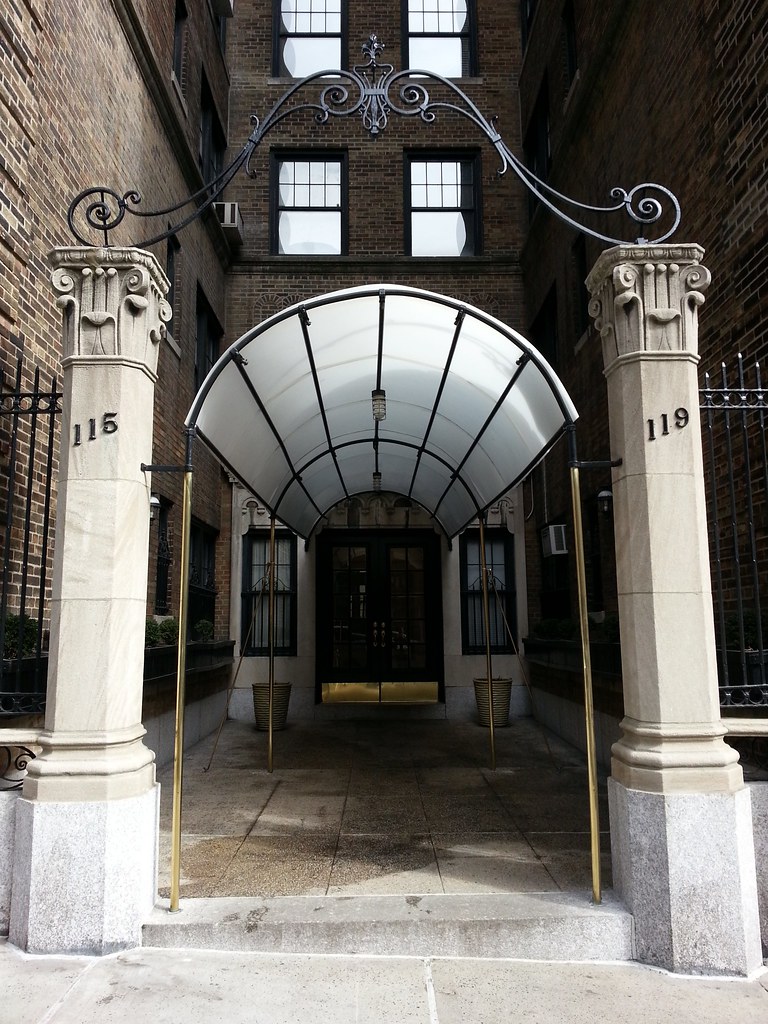
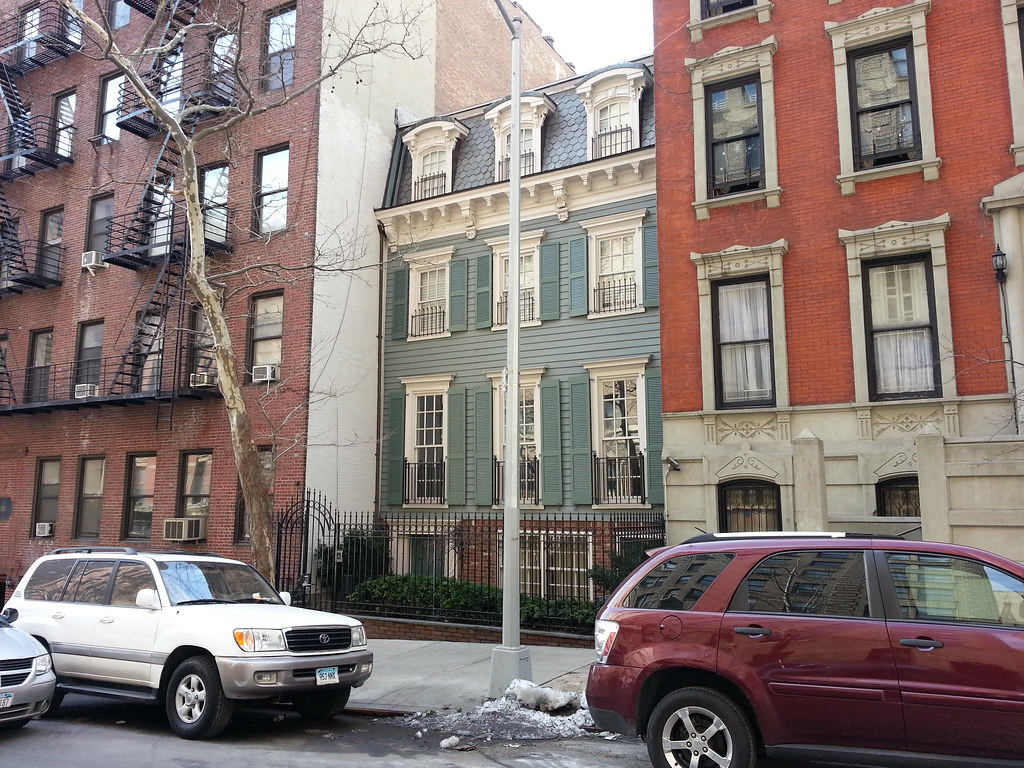
Built in 1866 (the top floor was added later in the 19th century) for a maker of artificial limbs, this clapboard house was until recently owned by C.C. Dyer, an ex-wife of Geraldo Rivera. Interior photos here.
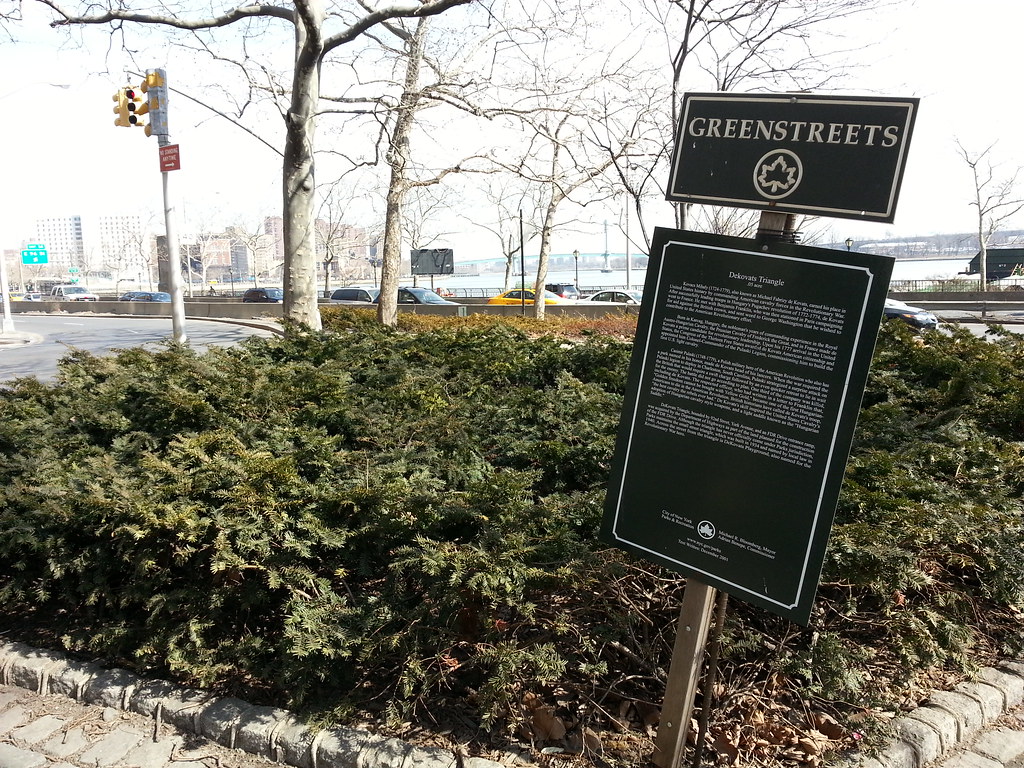
One of the city's more obscure memorials, this isolated little traffic island, accessible from the nearest sidewalk by jogging across an FDR Drive entrance ramp (Street View), is named for a Hungarian cavalry officer who fought for the Americans in the Revolutionary War.

This is the national headquarters of the ASPCA and the former home of Humility of Man Before A Group of Ageless Animals. Here's a close-up of the organization's seal, above, which depicts an angel intervening to keep a man from beating his horse.

Built in 1852-53, this is "one of the oldest of the few intact nineteenth-century wooden houses which remain in Manhattan north of Greenwich Village, [dating] from a period in which many of the houses on the outskirts of the city were of frame construction (prior to the implementation of an overall ban in Manhattan, due to fire hazards)." According to the AIA Guide to New York City, Eartha Kitt once called this place home.
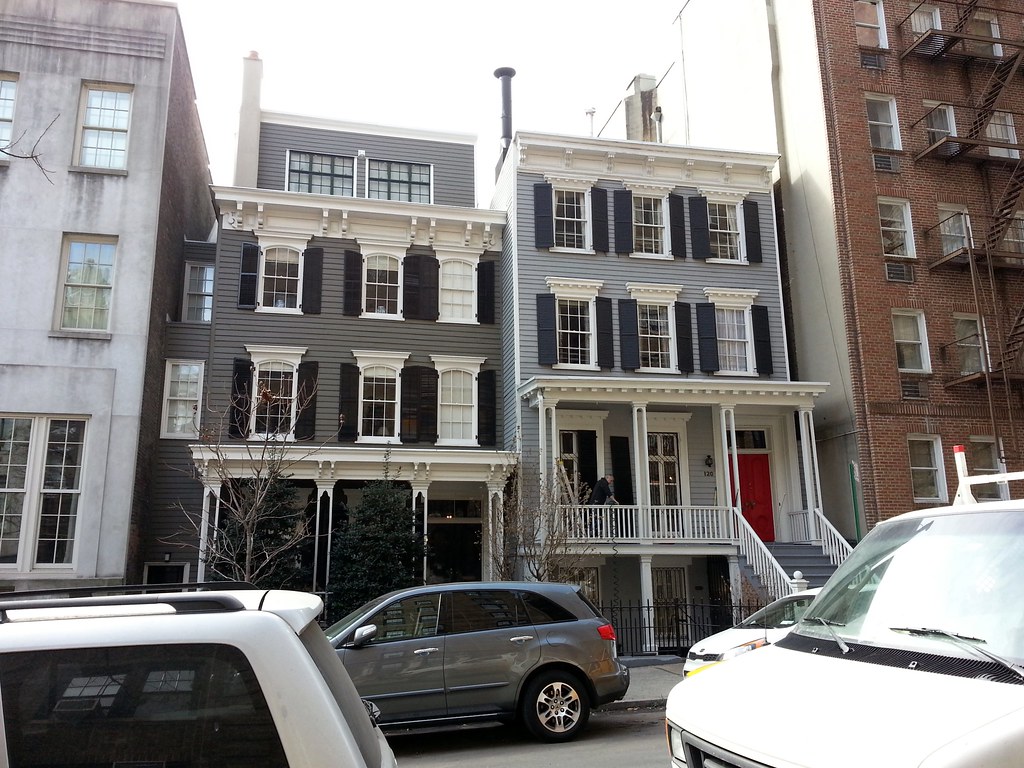
Outside of Gracie Mansion, there are only four remaining wood-frame structures on the Upper East Side, and now we've passed by all of them today! No. 122, on the left, was built in 1859, and No. 120 was built in 1871.
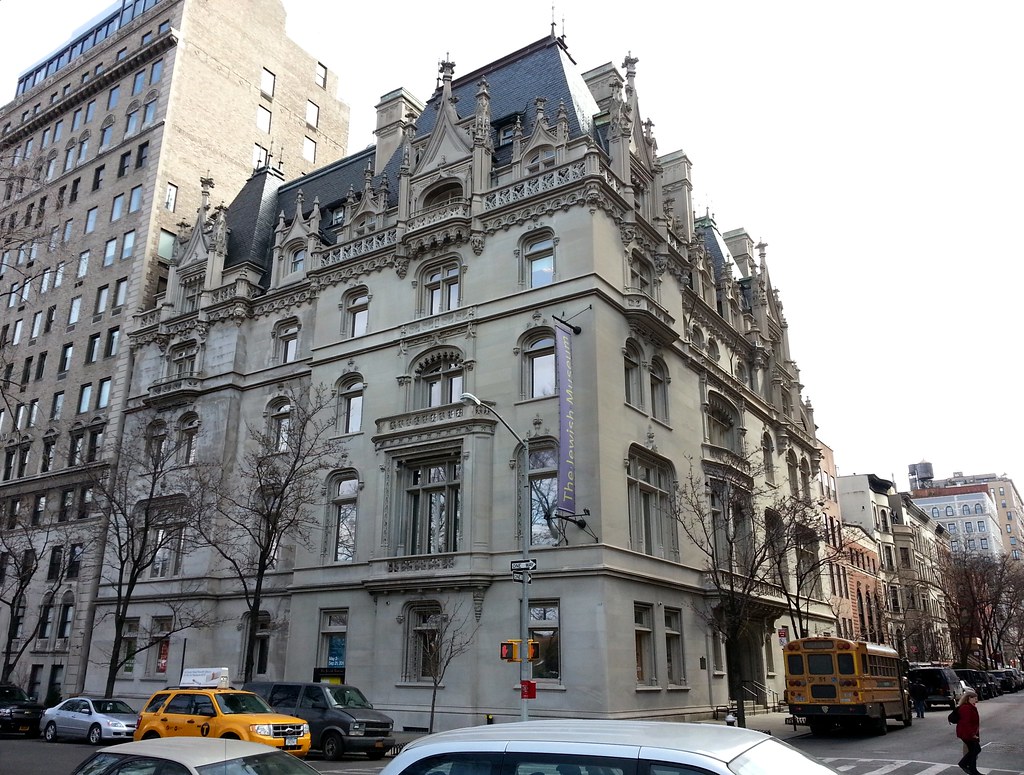
Now home to the Jewish Museum, this is the 1908 Warburg mansion, one of the few survivors from a time when an "astonishing panoply of millionaires' mansions" lined the east side of Fifth Avenue, facing Central Park.
Well, to be more precise, the right half of the building is the 1908 Warburg mansion (photo). The almost identical left half, believe it or not, was constructed in the early 1990s as an addition to the museum. (As you can see, there is one visual giveaway that something's different about the left half: the newer limestone doesn't appear to be weathering so well. I've read that the ornamental features of the addition were carved from stone taken from the same quarry that was used for the original building, but I don't know if that applies to the rest of the new facade as well.)
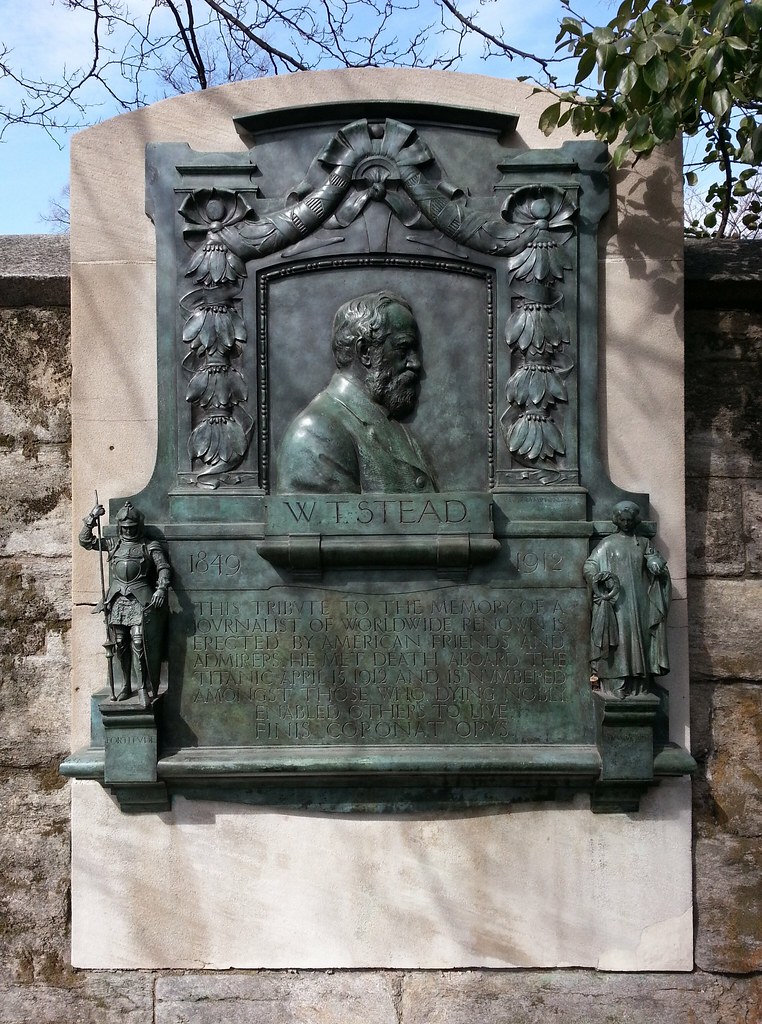
This bronze bas-relief at the edge of Central Park, a replica of the original located on a Thames River promenade in London, memorializes William Thomas Stead, the British "Father of Tabloid Journalism", who lost his life on the Titanic.
An "unabashed sensationalist" and moral crusader, Stead was most famous for his lurid 1885 exposé of child prostitution in London, which he wrote to stoke societal outrage and prompt Parliament to pass a bill that would raise the age of consent for girls from 13 to 16. His campaign was quite successful in these regards, but it also landed him in prison after it was revealed that, as part of his investigation, he had arranged for the purchase of a 13-year-old girl from her parents and had her briefly sent to a brothel. While the girl was never actually prostituted, Stead twice had her examined to certify her virginity, which is to say she was effectively sexually assaulted twice. Although an extreme case, this incident shows how far the man was willing to go to get the story he wanted, in this instance a firsthand account of how easy it was to procure a young girl for prostitution. Of course, he declined to mention his personal role in the affair when he included the girl's tale in his exposé, calling her story "only one of those which are constantly occurring in those dread regions of subterranean vice in which sexual crime flourishes almost unchecked."
(In case you're counting, this is now the second Central Park monument we've seen honoring a man who had a controversial relationship with women's private parts. The first is located just twelve blocks north of here.)
In the 1890s, Stead became increasingly interested and involved in spiritualism. He published many works on supernatural matters, including a collection of "letters" he said were conveyed to him through automatic writing by a deceased acquaintance. Some believed he had foreseen his death on the Titanic in two fictional pieces he had written: an 1886 cautionary tale of the sinking of a trans-Atlantic steamer with an insufficient number of lifeboats — also like the Titanic, it had departed England for New York, and had made its final European stop at Queenstown (now Cobh), Ireland — and an 1892 story that involves a ship striking an iceberg in the North Atlantic.
Stead also became an ardent advocate for peace in his later years; in fact, he was on his way to New York to deliver an address on the subject when he died on the Titanic. I found a satirical 1907 NY Times account of his tireless speechifying entitled "W.T. Stead, Inventor of the Continuous Speech, the Basis of Universal Peace". Here's an excerpt of an imagined transcript of his speeches:
Montreal, May 3.
[After briefly speaking about peace...]
If you want to hear the rest of this you must get berths on the train to Pittsburg. It is with great sorrow —
Pittsburg, May 3.
— that I have to inform you, ladies and gentlemen of Pittsburg, that I have only five minutes in which to take the fifteen minutes' ride to your depot. Pittsburgers, when coal is no longer being burned in this world, when steel is pointed out in museums as a relic of barbarism, when libraries are being torn down to make statues of Me and Peace, Pittsburg will be remembered as the city which provided the stage setting and gate receipts for my speech of to-day. Yes, sir, it will be remembered,
Buffalo, May 3.
— Buffalo will, as the city which provided a hall for the speech I spoke between Pittsburg and —
Milwaukee, May 3.
— Milwaukee. Ladies and gentlemen, the speech that made Milwaukee famous is about to eventuate. Beer and Peace go hand in hand. Nobody ever felt warlike after drinking beer. No, ladies and gentlemen. After dallying with the god Gambrinus, people are sleepy. Now, no nation is so peaceful as a nation asleep. Hence, when the history of the Universal Peace movement is written in deathless script, whatever that may be, the name of Milwaukee will be cited therein as being the city that drugged the gods of war, calmed the ferocious instincts of man, laid low the internal clamorings that bid us go out and kill something, and—and otherwise acted most sensibly and wisely. I am aware that that is a lame sentence, ladies and gentlemen, but you ought to hear some of my sentences. And I don't worry, anyhow. I care not who understands my speeches provided thousands hear them. Goodby. Send my luggage to Syracuse—I mean Cleveland.

This is one of the four sunken transverse roads that keep crosstown traffic mostly hidden as it moves through Central Park.
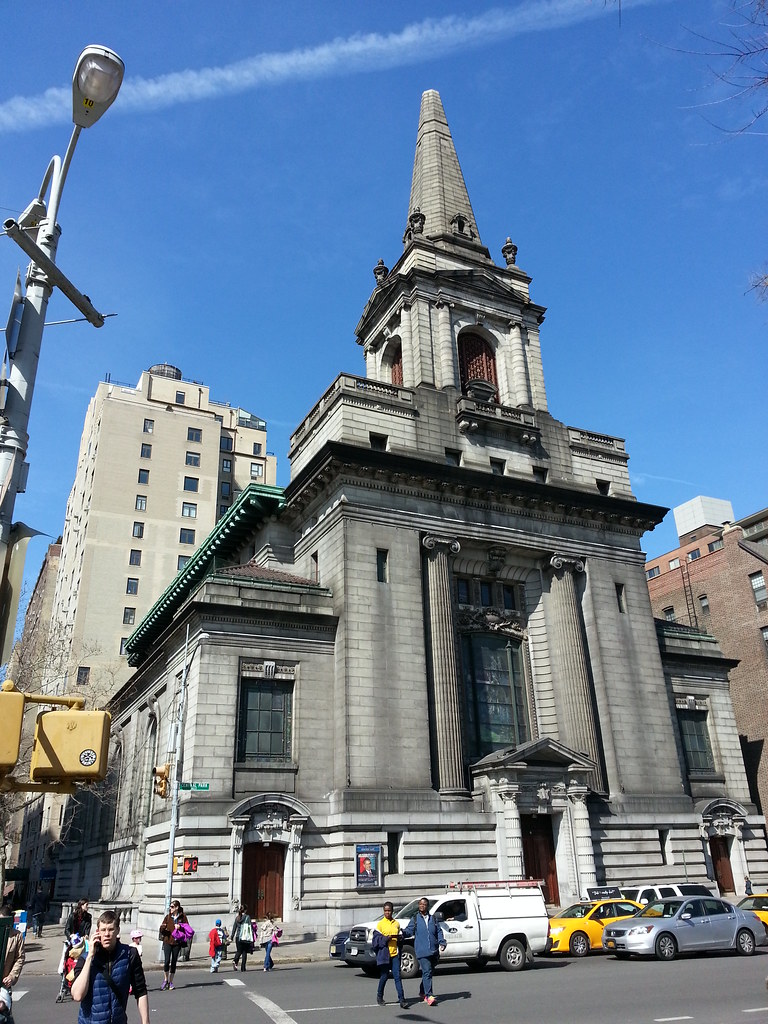
Now home to the East Coast branch of Crenshaw Christian Center, the L.A. megachurch known for its massive FaithDome, this imposing 2,200-seat edifice (interior photo) was completed in 1903 for the First Church of Christ, Scientist, which occupied the place for the next 100 years. Augusta Stetson, one of the women who brought Christian Science to New York, was the head of the church at the time of construction, having previously driven off a fellow church pioneer who then went on to found a rival congregation. "Endowed with boundless energy and executive capacity, audacious, abrasive, unbending and ruthless, yet adored by hundreds of students and church members", Ms. Stetson was a strong and forceful leader whose personal ambition strained relations with the Mother Church in Boston and eventually got her excommunicated in 1909. (Note the adjacent story in the newspaper I just linked to: "TARANTULA IN MAIL. Throws Dead Letter Office Clerks Into Frenzy.")
Promoting herself as the true spiritual heir of Mary Baker Eddy, the founder of Christian Science, Ms. Stetson maintained a considerable following after her excommunication and even began taking out full-page (and sometimes multiple-page) ads in prominent newspapers to feud with the church establishment and present her teachings directly to the masses (as well as to publicly wage a successful battle against the "spite wall" that the church wanted to erect between its own building and the mansion she lived in next door). She proclaimed that Ms. Eddy would be returning from the dead shortly, and also "announced, with all solemnity and seriousness, that she [herself] would never die. She made it clear she meant this in no metaphorical sense and that she did not have reference to the immortality of the soul. She simply would not die."
(She did though.)

"The Ungainly Duckling That Alighted Along the Park" is apparently home to one or more valuable rugs.
Probably the most famous residents of the Braender were Winifred Sackville Stoner and her daughter of the same name, who lived here in the 1920s. Winifred Jr., born in 1902, had been celebrated as a child prodigy, "the roly-poly girl who talks eight languages and teaches school and writes poetry and does a score and one things additional that stamp her as the most unusual of 12-year old girls". Winifred the Elder insisted that her daughter was not particularly gifted, however, and that it was the system of "natural education" that she had devised for her daughter that had allowed her to flourish.
A key part of this educational system was the creation of little poems or jingles to help keep facts straight. Young Winifred was a rather prolific author of such verse. (Here's one of the collections she published.) Her most well-known poem, "The History of the U.S.", begins with a couplet you may have heard before: "In fourteen hundred ninety-two / Columbus sailed the ocean blue". Don't give her credit for that rhyme, however. It was around well before she was, as this joke makes clear.
Mother Stoner (or "Mother to All Children", as she was sometimes billed when speaking about her educational methods) much preferred these practical, factual rhymes to the "immoral, un-American, brutal, ungrammatical, silly, and salacious" tales of Mother Goose, which
[teach] children to lie and steal—in some cases to take life. . . .Mrs. Stoner's eyes were opened to the grievous flaws of Mother Goose when her three-year-old daughter called her out as a liar for suggesting that a cow could jump over the moon, that a dog could laugh, and that a dish could run away with a spoon. She relates that story in this absurd 1925 article, in which she also offers her criticisms of several popular nursery rhymes, including:
No one should misinterpret life to children. It is not only criminal to do this, but it makes criminals of children. Mother Goose nourishes fear and inferiority complexes. And Mother Goose is so English in its terms that the child forgets he is an American, unruled by king or sixpence.
Goosie, goosie, gander,In 1927, mother and daughter took off across the US and Europe, respectively, on a hunt for young geniuses. According to an article about their search, "All the children thus discovered will be brought back to New York", where Mrs. Stoner would foster their brilliance under her educational guidance. The article goes on:
Where shall I wander?
Upstairs, downstairs,
In my lady's chamber,
There sat an old man who wouldn't say his prayers.
I took him by the left leg and pulled him down the stairs.
"The rank immorality of this poem is evident at once," she comments. "What was that old man doing in the lady's chamber? His presence there was improper and a violation of all decent conventions. I would substitute for this atrocious piece of loose morals something like this:
Dirty face, dirty face, you are a fright;
Dirty face, dirty face, get out of my sight!
Pretty face, pretty face, clean as can be;
Pretty face, pretty face, stay always with me!
"This takes the attention from the goose, the most stupid animal in all nature, and focuses it on one of the first Christian virtues, cleanliness. We mothers cannot begin soon enough to teach the beauty of cleanliness to children."
The world is divided into six classes, in which the hyper-morons—otherwise the rank and file of human beings—predominate, according to Mrs. Stoner. These classes are:This might be hard to believe, given her perfectly normal-sounding childhood, but Winifred Jr. had a rough go of it as an adult. In 1921, at the age of 18, she married an urbane French count named Phillippe Clinton de Bruche who turned out to be a duplicitous German con artist known to the police as Robert Hemholtz. (His pseudonyms, especially the French one, vary somewhat from one article to another.) After she began divorce proceedings, the phony count reportedly died in an automobile accident in Mexico in 1922 (her family held the funeral service here at the Braender), only to reappear in New York in 1929 upon reading that Winifred had become engaged to former Secretary of State Bainbridge Colby.
(1), Idiots; (2), deconstructionists; (3), morons; (4), hyper-morons; (5), constructionists; and (6), geniuses.
Destructionists include anarchists, bomb throwers, etc., while constructionists are those striving to improve their business and include bank presidents, highwaymen and newspapermen.
"But the world is full of morons," she asserts. "The girl who wears furs in summer because it's the style is a moron. So is the man who wears a collar in hot weather. So is the minister who preaches the same old stuff from the pulpit. Morons, in brief, are those who blindly follow in the rut."
In the intervening years, before she found out de Bruche/Hemholtz wasn't actually dead, Winifred Jr. had married again, making her an unintentional bigamist. The relationship didn't last long, however, and the papers ate it up when the couple split, especially when it came out that Winifred's husband thought she made a lousy cup of coffee. Headlines included "Speaks Seven Languages, But Cannot Make Coffee—So She Loses Husband" and "Wonder Child's Intellect Bad For Marriages".
In a 1930 newspaper article, Winifred Sr. admitted she made some mistakes in raising her daughter. (Of course, this admission was coupled with an announcement that she was working on a book about "why her perfect child hasn't found happiness.") Her biggest regret? "Not staying at home and being an old-fashioned matchmaker for Winifred."
Winifred Jr. got married for a third time in 1931, but she and her new husband called it quits a few days later, at which point her mother proclaimed: "Winifred is now cured of matrimony. She will stick to her books instead of showing interest in men whose pedigree she does not know."
The last article I could find about Winifred Jr. told of her filing a charge in 1937 with the district attorney against a man she claimed stole $7,000 worth of her jewelry, but then abruptly fleeing the DA's office when she saw two detectives arrive with warrants for her arrest on charges of bail-jumping and petty larceny (stemming, I believe, from an unpaid hotel bill).
I also found a website with some bare-bones info on Winifred Jr. collected from various publications over the years. According to that site, she got hitched two more times in her later years. It sounds like the first marriage lasted about 18 years, from 1943 until her husband's death, and the second lasted another 18 and change, from 1964 until her own death in 1983. (Man, this is my most gossipy post ever.)

One of four art cars by Lalainya of the Vortex Creative Art and Design Center. You can see a few more shots I took here.
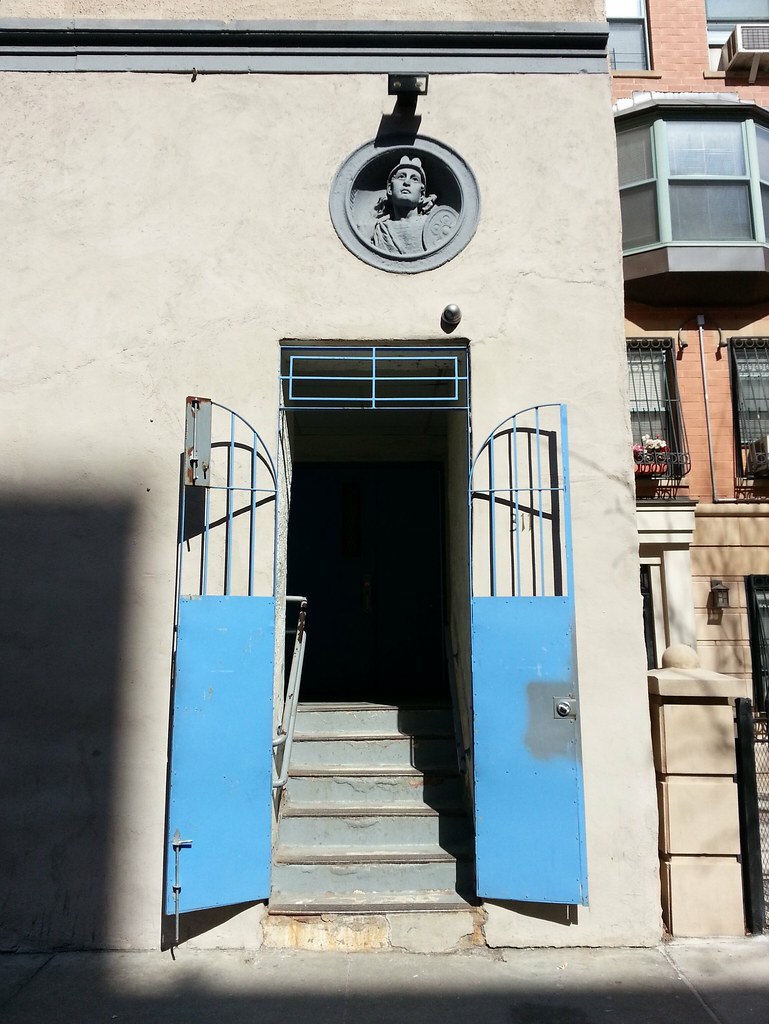
Currently home to the New York French American Charter School, this building began its life around 1904 as a Schinasi Brothers cigarette factory run by Solomon and Morris Schinasi, who had immigrated to the US in the 1890s and found great success introducing Turkish tobacco to American smokers. The building's appearance has changed dramatically over the years, as you can see. There are still some visible vestiges from the days of tobacco, however, including two seemingly inscrutable circular reliefs on the facade. The one pictured, it turns out, is a three-dimensional version of a soldier found on the label of Schinasi Bros. Natural cigarettes, while the other (photo) features an emblem of the company's Egyptian Prettiest smokes.
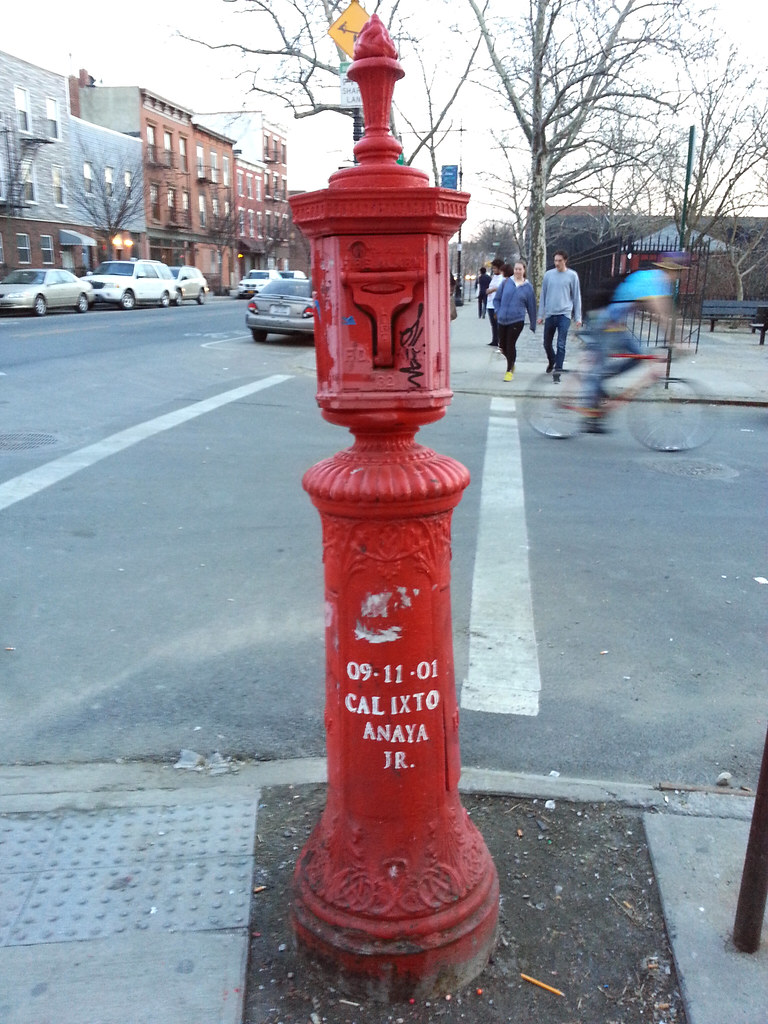
A deceased firefighter memorialized on an FDNY call box. (Spotted on an unofficial evening stroll through Greenpoint.)


